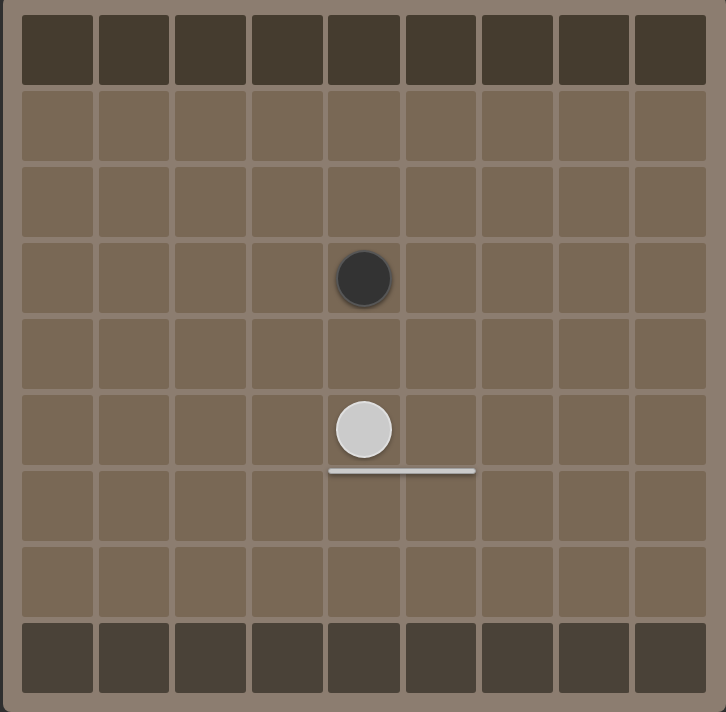Guide to 'The Standard' Opening
'The Standard' is called standard for a reason: it's the most balanced and fundamentally sound opening in Quoridor. Its core philosophy is to achieve a perfect equilibrium between advancing your pawn (offense) and using walls efficiently (defense). This strategy aims to create a small but lasting advantage by controlling the center and creating a more efficient path to the goal.
How to Play 'The Standard'
Step 1: Initial Pawn Moves
The first 2-3 turns are dedicated to pawn advancement. Moving your pawn straight forward is the most efficient way to reduce the distance to your goal. This establishes a presence in the center of the board and keeps your options open for moving left or right later in the game.
Step 2: The Key Wall Placement
This is the defining move of the opening. After advancing your pawn, you place your first wall defensively **behind your pawn**. The ideal placement creates a "path differential"—it makes your opponent's path longer without affecting your own. This single, highly efficient wall forces an immediate reaction from the opponent.

Step 3: Mid-Game Transition
After your first wall, your strategy is to maintain the advantage you've created. Your opponent must now choose how to deal with your wall.
- If they race past it: Use your next wall to directly intercept their path, punishing their lack of defense.
- If they place a counter-wall: Continue advancing your pawn. The game now becomes a patient battle of who can use their remaining walls more efficiently to create the shorter path.
Your goal is to always keep your path to the finish line shorter than your opponent's, using your walls sparingly to maintain that advantage.
Pros and Cons
Pros
- Balance and Stability: It's a very solid opening that doesn't take unnecessary risks. It gives you a good position from which to handle any mid-game situation.
- Central Control: By advancing your pawn in the center, you exert control over the most important area of the board.
- Efficiency: The strategy is built on getting the most value out of every move, especially your first wall.
Cons
- Predictable: As the most common opening, experienced players will have well-practiced responses ready.
- Lacks Aggression: It doesn't create immediate threats. A single mistake can cause you to lose the initiative to a more aggressive player.
How to Counter 'The Standard'
Because 'The Standard' is so common, countering it effectively is a crucial skill.
1. The Mirror
Do the exact same thing: advance your pawn and place a defensive wall behind it. This leads to a symmetrical game where the winner will be the player who uses their subsequent walls more cleverly to break the balance and create a path advantage.
2. The Aggressive Counter (Rush)
Ignore their wall and keep advancing your pawn. This is a high-risk strategy that aims to get a pawn lead so significant that the 'Standard' player is forced to use their walls inefficiently just to stop you. You trade wall advantage for pawn position.
3. The Counter-Wall
This is a strong tactical response. Instead of placing a wall behind your pawn, you place a wall that directly obstructs the 'Standard' player's future path. This forces them to commit to moving left or right earlier than they'd like, giving you information about their plan which you can then exploit.
'The Standard'가 표준이라고 불리는 데에는 이유가 있습니다. 쿼리도에서 가장 균형 잡히고 근본적으로 견고한 오프닝이기 때문입니다. 핵심 철학은 자신의 말을 전진시키는 것(공격)과 벽을 효율적으로 사용하는 것(수비) 사이의 완벽한 균형을 이루는 것입니다. 이 전략은 중앙을 장악하고 목표 지점까지 더 효율적인 경로를 만들어 작지만 지속적인 이점을 만드는 것을 목표로 합니다.
'The Standard' 플레이 방법
1단계: 초반 말 움직임
첫 2~3턴은 말을 전진시키는 데 집중합니다. 말을 앞으로 똑바로 움직이는 것이 목표 지점까지의 거리를 줄이는 가장 효율적인 방법입니다. 이는 보드 중앙에 존재감을 드러내고, 나중에 게임에서 왼쪽이나 오른쪽으로 움직일 수 있는 선택지를 열어둡니다.
2단계: 핵심적인 벽 배치
이것이 이 오프닝을 정의하는 움직임입니다. 말을 전진시킨 후, 첫 번째 벽을 자신의 **말 뒤에** 수비적으로 배치합니다. 이상적인 배치는 "경로 차이"를 만들어냅니다. 즉, 자신의 경로에는 영향을 주지 않으면서 상대방의 경로를 더 길게 만듭니다. 이 하나의 매우 효율적인 벽은 상대방의 즉각적인 반응을 강요합니다.

3단계: 중반 전환
첫 번째 벽을 설치한 후의 전략은 당신이 만든 이점을 유지하는 것입니다. 상대는 이제 당신의 벽에 어떻게 대처할지 선택해야 합니다.
- 만약 상대가 벽을 지나쳐 달린다면: 당신의 다음 벽을 사용하여 상대의 경로를 직접 가로막아, 그들의 수비 부족을 응징하세요.
- 만약 상대가 맞불 벽을 놓는다면: 계속해서 당신의 말을 전진시키세요. 이제 게임은 남은 벽을 누가 더 효율적으로 사용하여 더 짧은 경로를 만드는지에 대한 인내심 있는 싸움이 됩니다.
당신의 목표는 항상 결승선까지의 경로를 상대방보다 짧게 유지하고, 그 이점을 유지하기 위해 벽을 아껴서 사용하는 것입니다.
장점과 단점
장점
- 균형과 안정성: 불필요한 위험을 감수하지 않는 매우 견고한 오프닝입니다. 어떤 중반 상황에도 대처할 수 있는 좋은 위치를 제공합니다.
- 중앙 장악력: 중앙으로 말을 전진시킴으로써 보드의 가장 중요한 영역을 통제합니다.
- 효율성: 이 전략은 모든 수, 특히 첫 번째 벽에서 최대의 가치를 얻는 것을 기반으로 합니다.
단점
- 예측 가능성: 가장 일반적인 오프닝이므로, 숙련된 플레이어는 잘 연습된 대응책을 준비하고 있을 것입니다.
- 공격성 부족: 즉각적인 위협을 만들지 않습니다. 한 번의 실수는 더 공격적인 플레이어에게 주도권을 잃게 만들 수 있습니다.
'The Standard' 대응법
'The Standard'는 매우 흔하기 때문에, 효과적으로 대응하는 것은 중요한 기술입니다.
1. 미러링 (Mirroring)
똑같이 따라 하세요. 당신의 말도 전진시킨 후, 그 뒤에 수비적인 벽을 설치하세요. 이는 대칭적인 게임으로 이어지며, 승자는 균형을 깨고 경로 이점을 만들기 위해 후속 벽을 더 영리하게 사용하는 플레이어가 될 것입니다.
2. 공격적 대응 (러시)
상대의 벽을 무시하고 계속해서 당신의 말을 전진시키세요. 이것은 'Standard' 플레이어가 당신을 막기 위해 비효율적으로 벽을 사용하도록 강제할 만큼 상당한 말 우위를 얻으려는 고위험 전략입니다. 당신은 벽의 우위를 말의 위치와 교환하는 것입니다.
3. 맞불 벽 (Counter-Wall)
이것은 강력한 전술적 대응입니다. 당신의 말 뒤에 벽을 놓는 대신, 'Standard' 플레이어의 미래 경로를 직접 방해하는 벽을 설치하세요. 이것은 그들이 원하는 것보다 일찍 왼쪽이나 오른쪽으로 이동하도록 강요하며, 당신은 그들의 계획에 대한 정보를 얻고 이를 이용할 수 있습니다.